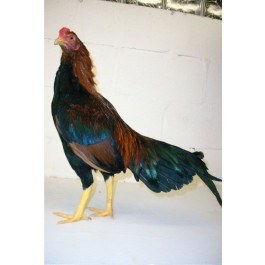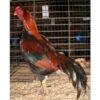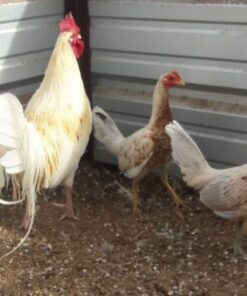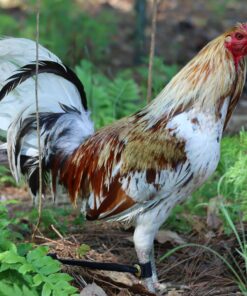Wheaten Aseel
$400.00 – $1,400.00Price range: $400.00 through $1,400.00
Appearance: Fierce
Agility: 8/10
Type: Offensive Fighter
Records: 10 Draws, 3 Losses, 17 Wins.
Fight Score: 7.8/10
Fight Ratings: Good
Wheaten Aseel
A Majestic and Ancient Game fowl Breed
The Wheaten Aseel is a distinguished variety of the Aseel (or Asil) chicken, renowned for its ancient lineage, robust physique, and striking appearance. Originating from the Indian subcontinent, this breed has a rich history intertwined with cultural traditions and is celebrated for its ornamental and exhibition qualities.
🐔 Origins and History
The Aseel breed is among the oldest known game fowl breeds, with its roots deeply embedded in the Indian subcontinent. The term “Aseel” translates to “purebred” or “from pure descent,” reflecting the breed’s esteemed lineage. Recognized by the American Poultry Association (APA), the Wheaten variety was officially accepted into the Standard of Perfection in 1996, joining other recognized varieties such as Black-Breasted Red, Dark, Spangled, and White .
🌾 Physical Characteristics
Wheaten Aseels possess a compact and muscular build, characterized by:
-
Size: Roosters typically weigh around 5½ pounds, while hens are approximately 4 pounds.
-
Feather Color: Roosters exhibit golden to reddish hackles and saddle feathers, complemented by creamy or pale wheat-colored body feathers. Hens display soft tan to pale wheat tones throughout, with minimal contrast.
-
Body Structure: They have short, hard, glossy feathers tightly adhering to their solid, compact bodies. Their upright stance and broad skull contribute to their regal appearance .
🧠 Temperament and Behavior
Wheaten Aseels are known for their assertive and territorial nature. Key behavioral traits include:
-
Aggression: Males, in particular, are highly territorial and may exhibit aggression towards other roosters. It’s advisable to house them separately to prevent conflicts.
-
Broodiness: Despite their aggressive tendencies, Aseel hens are excellent mothers. They are supremely broody and have been known to protect their young fiercely, even from predators like snakes .
-
Social Interaction: While they can be aggressive towards other chickens, Aseels are typically personable with their human handlers, forming bonds with their caretakers .
🥚 Egg Production and Meat Quality
-
Egg Production: Aseels are not prolific layers. Hens typically produce between 6 to 40 small, cream-colored eggs annually. The eggs are known for their rich flavor, which some describe as stronger than that of other chicken breeds .
-
Meat Quality: Despite their slow growth, Aseels are valued for their meat, which is tender and flavorful. The meat is lean, with high protein content and minimal fat, making it a healthy choice for consumers .
🌍 Conservation Status
The Wheaten Aseel is considered a sustainable heritage breed and is listed as “Critical” on the American Livestock Breeds Conservancy’s Conservation Priority List. Efforts are ongoing to preserve and promote this ancient breed, ensuring its survival for future generations .
🏡 Care and Housing
Wheaten Aseels require ample space to roam and forage. They are not well-suited for close confinement due to their territorial nature. Providing them with a spacious and secure environment is essential for their well-being. Additionally, due to their aggressive tendencies, especially among males, it’s crucial to manage their housing arrangements carefully to prevent conflicts.
🎨 In Summary
The Wheaten Aseel is a breed that embodies strength, beauty, and tradition. With its ancient origins, striking appearance, and unique behavioral traits, it offers a fascinating addition to any poultry enthusiast’s flock. Whether admired for its ornamental value, appreciated for its meat quality, or respected for its cultural significance, the Wheaten Aseel continues to captivate those who encounter it.
| Select Fowl | Pairs, Pullets, Stags, Trio |
|---|---|
| Gender | Female, Male |
Be the first to review “Wheaten Aseel” Cancel reply
Related products
GAME FOWLS FOR SALE
GAME FOWLS FOR SALE
Fighting Roosters
GAME FOWLS FOR SALE
GAME FOWLS FOR SALE
Fighting Roosters
GAME FOWLS FOR SALE
Fighting Roosters













Reviews
There are no reviews yet.